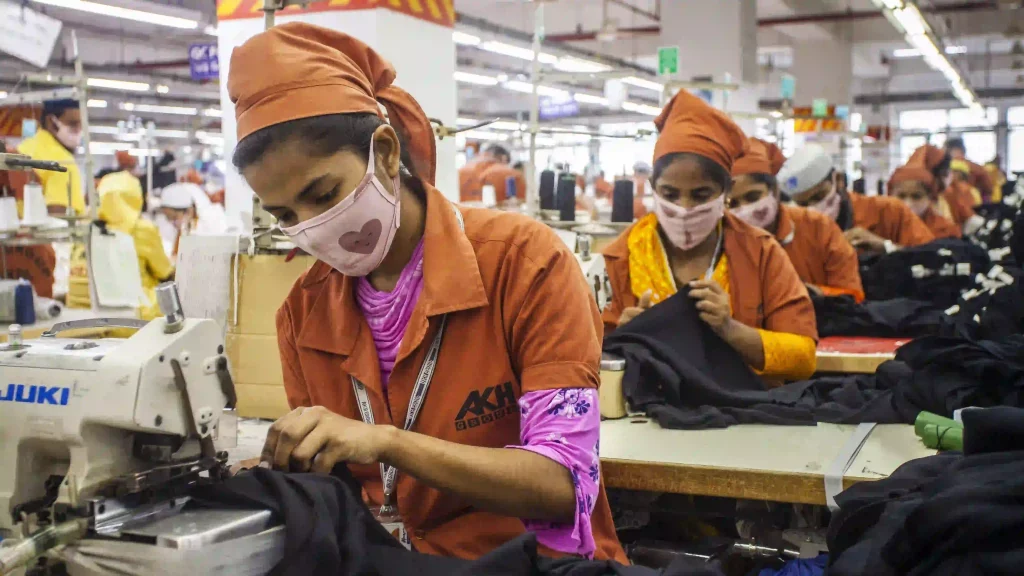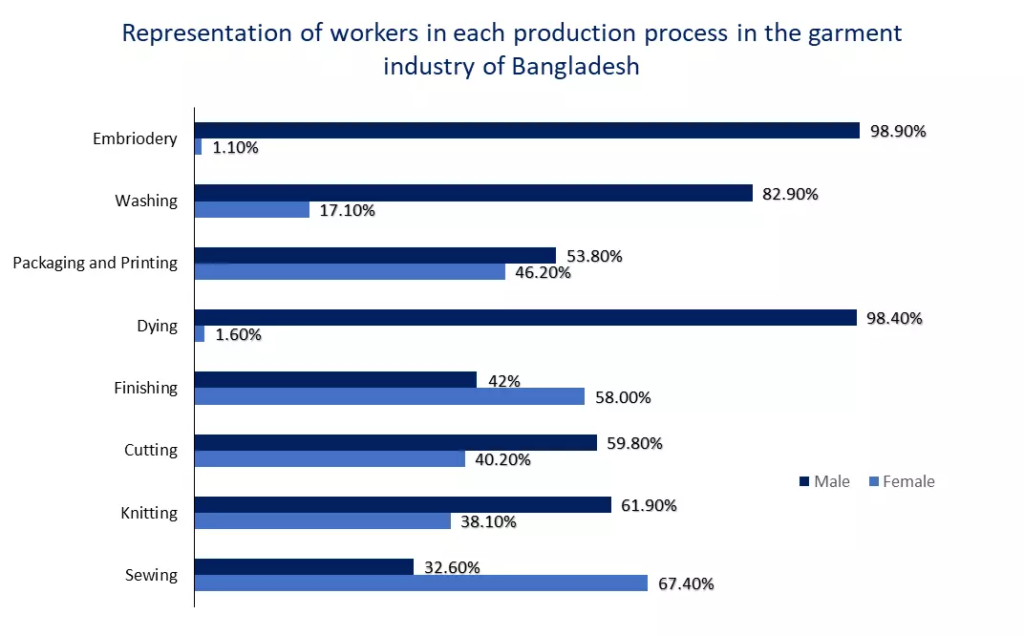
Early Retirement and Alternative Career Opportunities for Women RMG Workers in Bangladesh
Originally published on the LightCastle Partners website.
Changing Dynamics in the RMG Landscape
The utilization of materials and manufacturing techniques, as well as the addition of functionality and style, have advanced the garment business significantly over the ages. The worldwide revenue for apparel currently stands at USD 1.74 trillion in 2023 with women’s apparel, the market’s largest segment, having a market volume of USD 0.90 trillion in the same year.[1] This upward tendency has been accelerated by a number of factors, some of which include increased disposable income and per capita apparel expenditure in emerging economies.
Additionally, the textile and apparel production facilities are in a transitional phase between the realization of highly focused design and the manufacture of value-added clothing products from previously conventional production methods.
The garment business has had similar pros and cons as other sectors of society as a result of the 4th Industrial Revolution’s (4IR) ongoing impact on how people work and live. Through automation, artificial intelligence, 3D printing and knitting, robots & intelligent manufacturing, augmented reality, etc., the 4IR is disrupting traditional operational procedures. Increased automation has slowed down job growth in the RMG sector, and the World Bank predicts that this trend will likely continue and accelerate further in the years to come.
An apparel producer can be expected to save between 10% to 30% of their time by adopting technology.[2] As a result, Bangladesh cannot continue to compete on the world stage with its historically low labor-intensive productivity. Instead, businesses must swiftly implement new technology across all productions and operations in order to increase efficiency. Being economical is no longer the main necessity. To remain at the top of the field, increased manufacturing speed and shorter lead times are also required. However, as the need for automation and efficiency grows, so do other compounding forces.
Compounding Impact on Women Garment Workers Brought Upon by Shifting Dynamics
Aside from rising automation, the garment industry is also at the forefront of major global challenges when it comes to sustainability and worker well-being. Tasks are generally distributed based on gender in Bangladesh’s garments sector and most of the working circumstances for women employees are determined by this.[3] The sewing department mostly consists of women, whereas males predominantly work in the cutting, ironing, and finishing departments. Most typically, women work as helpers, machinists, and less frequently, as line supervisors and quality controllers. Female cutting masters can hardly be seen in the garments sector of Bangladesh.
The majority of managers and administrative positions are held by males. Access to management positions and higher-paying white-collar jobs is discriminated against for women. For women garment workers, there is very little opportunity for advancement. Additionally, as the burden of household work disproportionately falls more on women, the number of workers they can dedicate to work is also lower. Therefore, they also have a lesser inclination to opt for management positions. In a study by Brac University with assistance from the Ethical Training Initiative Bangladesh and the Deutsche Gesellschaft für Internationale Zusammenarbeit (GIZ), it was discovered that only 1% of workers served as supervisors, while 86% of workers entered the factory as helpers and left as operators.[3]

Additionally, according to a GIZ study conducted on the RMG workers of Bangladesh, the percentage of women employed in the apparel industry has been steadily declining since 2015. Lack of training, skills and proper knowledge of technology are one of the main reasons for the downfall. The drop stood at 53.89% in 2018 and 53.65% in 2021. Compared to the 1980s, this is a huge decrease, from a time when women made up 80% of the workforce in the garments sector. The slump can also be attributed to the slow annual growth rate of employment in the garment sector. According to a study by the Asian Centre for Development (ACD), employment in Bangladesh’s garment industry was around 1.07% annually from 2015 to 2020.[4]

Furthermore, the same study cited earlier depicted that while the average number of machines grew, the proportion of women employees declined with time in the cutting and sewing operations. Health risks are also a top concern for RMG employees in South and Southeast Asia. The working environment, which frequently falls short of acceptable norms of working conditions, lies at the basis of the problem of health vulnerabilities.[5]
Workers who are only meant to labor for eight hours a day sometimes work twelve.[6] Strenuous work of this level often leads to workers having long term health predicaments and declining efficiency as they age. Thus, leading to early retirement age as well. The average age of employees in Bangladesh’s RMG industry is 25.9 years old, according to 2020 research by Asian Centre for Development (ACD) titled A Survey Report on the Garment Workers of Bangladesh. While men workers’ average age is around 27, female workers’ average age is considerably lower at around 25.[7]
Since the nature of work requires high concentration and hard labor, older workers are often replaced by younger ones due to their ailing productivity and diminishing efficiency leading to increasingly early retirement. Garment workers also do not earn enough to avail nutritious food that would aid them to remain physically fit to continue hard labor at an older age. On top of that, female workers are further subjected to even lower pay grades compared to their male counterparts. The table below depicts the pay gap that is often witnessed between male and women garment workers.

Common Phenomenon of Early Retirement in the RMG Sector
Recent studies carried out by Awaj Foundation and Karmajibi Nari on 3,014 workers from 327 factories from Dhaka, Gazipur and Narayanganj also unveiled similar insights which further strengthened the claim that the number of active working years for RMG workers is relatively short.[7] The study found that the total average working experience for garment workers, especially females, was approximately 4.96 years and workers with more than 10 years of experience constituted a meager 8.4%.[8] Furthermore, once these garment workers retire at the early age of 35, they often go back to taking up jobs such as household help, sweeper, cleaner, etc.
Some women garment workers who have accumulated significant sewing and cutting skills open their own tailor businesses in their vicinity. Many people who have relocated from their hometown to work in the apparel business frequently return to their hometown and take up other agricultural jobs, such as raising cattle or raising poultry. They typically resort to less demanding jobs that are comparatively easier and give them flexibility in terms of allocated work hours. These professions are, however, also less lucrative, which results in a return to reduced living standards. This proves that after these retired garment workers quit their individual occupations, there are no longer any formal avenues of income available to them.
Additionally, because they are used to participating in one specific aspect of the garment manufacturing process repeatedly, they frequently lack the knowledge or comprehensive competence necessary to execute a whole line of duties necessary to generate a finished product. They frequently lack the knowledge necessary to perform meaningful employment after retirement as a result. Therefore, further leading into lower perception of self-worth.
Studies have also revealed that female employees often leave their jobs voluntarily giving family responsibilities as their justification. As the lengthy hours of the garment job do not provide them the opportunity to work and take care of the home at the same time, they frequently choose to participate in reproductive and care-giving activities instead. Eighty-nine percent of the polled former women garment workers indicated that their departure was voluntary, according to a study done by GIZ and BRAC University.
According to 26.67% of those polled, taking care of children was the primary cause in workers quitting the factories, followed by being pregnant (17.89%), employees’ perceptions of age appropriateness (11.93%), and trouble juggling work and home (10.52%). According to the poll, 27% of current female RMG employees and 8% of all women overall expressed a desire to quit the industry after five years due to the increasing health implications they face and compounding family duties.
Creating More Opportunities and Facilitating a More Seamless Transition for Women Garment Workers
Upskilling and reskilling garment workers, so they may continue to work meaningfully far into retirement age, is one strategy for reducing the issue of early retirement. Shimmy Technologies is one such business that has invested a lot of time and energy into this area. Along with the H&M Foundation, Asia Foundation, and Care Bangladesh, they started their upskilling training program with 650 women garment workers in September 2021. The program has made a quantifiable difference in the lives of Bangladeshi women who work in clothing factories by giving them the skills they need to go from manual laborers who can only do a single task to digital technicians who can handle a variety of equipment. They have dismantled the hurdles that have kept female workers from progressing into better-skilled occupations by utilizing the training program outcomes to unbiasedly argue for promotion. Other organizations engaged in similar initiatives are BRAC, Swisscontact, BGMEA, BKMEA, Sarathi, etc.
Another such initiative to upskill workers was taken by DBL Group through their Female Supervisor Leadership Program, where female workers undergo a series of training that eventually equips them to take up a leadership role in the factory space. Thereby, enhancing the upward mobility of female garment workers. However, businesses, factory owners, and governments will need to make large financial commitments in order to reskill manufacturing workers. If it is done successfully, garment workers will be able to remain actively employed for a longer period of time and will also be equipped with the required skills to pursue other alternative work opportunities. This in turn will allow women garment workers to continue to economically and financially contribute to their household and maintain an alleviated standard of living.
A career pathing program may also be implemented in the manufacturing setting. The programme may be utilized by the employee to map out a path for their own professional advancement and point them in the direction of alternative employment prospects after retirement so they won’t have to settle for lower-paying positions. Social safety programs like sick pay, unemployment benefits, and accident insurance should be made mandatory in addition to fostering a culture of talent mobility. Retirement benefits have to be included as well, allowing retired people to launch their own firms when they leave the workforce.
A number of donor organizations, NGOs and private enterprises have been actively involved in addressing worker well being issues throughout the RMG value chain from a number of perspectives. Some of the initiatives undertaken under different dimensions have been highlighted in the table below.

References:
[1] Worldwide Apparel- Statista
[2] Automation and Robotics are Blessing in the Apparel Industry
[3] Understanding Gender Composition and Experience of RMG workers in Bangladesh
[4] Employment growth in Bangladesh RMG sector 1.07% a year
[5] Well-being of the RMG Workers in Bangladesh: Some Key Issues
[6] Long working hours, a major challenge in RMG sector: Study
[7] Approaching 30? Apparel industry no longer needs you
[7] New Report Finds Protection Lacking for Women Workers in Bangladesh Garment Sector
[8] Most workers leaving RMG jobs aged 35 years
[9] Building skills for Unemployed and Underemployed Labor
[10] Working towards SDG3: making health and well-being a priority in Bangladesh’s garment industry
[11] Sarathi-Swisscontact
[12] SNV in Bangladesh menstrual hygiene week in garment factories
[13] BSR HerProject
Author
Sutopa Ahmed, Business Analyst at LightCastle Partners, has prepared the write-up. For further clarifications, contact here: [email protected].

